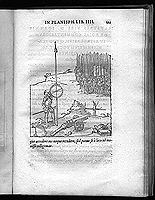 Fig. 61
Fig. 61
 Fig. 61
Fig. 61
Astronomical calculation, including related problems such as time-telling, is regarded as the principal function of the astrolabe and the ingenuity and sophistication of both maker and designer are particularly evident on the front of the instrument, where such calculations are performed. However tracts on the astrolabe often seek to illustrate its general usefulness, and the back is particularly helpful to authors intent on demonstrating a universal functionality. This is because the pivoted alidade or sighting rule moving across a circular scale of degrees, whose astronomical use would be for taking the altitude of a star or of the sun, has many possible applications. It can be used in surveying, for example, or in any enterprise involving the measurement of altitudes (vertical angles) or bearings (horizontal angles). The point is reinforced on the backs of most astrolabes by the inclusion of a 'shadow square' or 'geometrical quadrant' (see figure 62), where such angles can be measured as ratios (in trigonometrical terms, as tangents expressed as fractions). In the case of an altitude measurement, for example, the ratio would be that between the horizontal and vertical distances from the observer to his target; if either of these distances are known, the other can readily be calculated using the measured ratio.
Military applications are often cited in accounts of the usefulness of the back of the astrolabe. Its general relevance to surveying includes military installations and fortifications, and finding the altitude of the target is necessary for setting a gun. It can also be applied to range-finding. This could be done by triangulation with the instrument horizontal. Alternatively, the shadow square in a vertical orientation can measure the ratio between an object whose approximate height is known, or easily estimated, and the horizontal distance required by the gunner.
The tract selected here is by Juan de Rojas, whose name is associated with a type of universal astrolabe: it carries a particular projection of the spherical co-ordinate lines of the heavens and can be used for astronomical calculation in any latitude. However, despite the ingenuity of this development on the front of the instrument, a significant proportion of his book is devoted, as was customary, to the application of the scales on the back to surveying in civil and military contexts.
Rojas's book is dedicated to his patron, Emperor Charles V, who had a sustained interest in practical geometry and mathematical instruments. The example Rojas chooses to illustrate the relevance of the astrolabe to warfare is the celebrated expedition against Tunis, led in person by Charles in 1535. The engraving showing the astrolabe in use suspended from a lance (hasta) may well be intended to depict the Emperor himself (see figure 61).